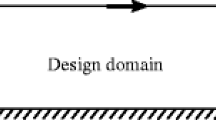Abstract
In the product development process topology optimization can successfully be applied in the early product design stages. In this work a new penalization scheme for the SIMP-method (Solid Isotropic Material with Penalization) is presented. One advantage of the presented method is a linear density-stiffness relationship, which has advantages for self-weight or eigenfrequency problems. The optimization problem is solved through derived optimality criteria (OC), which is also introduced in this paper. The derived OC uses no sensitivities of the optimization function but is equivalent to the classical OC in the case of no penalization. In the case with penalization we present an objective function for the penalty factor. By maximizing the objective function in each iteration, we get an adaptive penalty factor. Numerical experiments show, that the adaptive penalty factor leads to better optimization results then a fixed penalty factor. The presented topology optimization method is implemented in the commercial FEM package ANSYS under the name TopoAD. One useful extension of TopoAD is the concept of “meta elements”, which is also presented in this paper.













Similar content being viewed by others
References
Bendsøe MP (1989) Optimal shape design as a material distribution problem. Struct Optim 1:193–202
Bruyneel M, Duysinx P (2005) Note on topology optimization of continuum structures including self-weight. Struct Multidiscip Optim 29(4):245–256
Pedersen NL (2000) Maximization of eigenvalues using topology optimization. Struct Multidiscip Optim 20(2):2–11
Petersson J, Sigmund O (1998) Slope constrained topology optimization. Int J Num Methods Eng 41:1417–1434
Stolpe M, Svanberg K (2001) On the trajectories of penalization methods for topology optimization. Struct Multidiscip Optim 21:128–139
Stolpe M, Svanberg K (2001) An alternative interpolation scheme for minimum compliance topology optimization. Struct Multidiscip Optim 22:116–124
Bendsøe MP, Sigmund O (1999) Material interpolation schemes in topology optimization. Arch Appl Mech 69:635–654 Springer
Rozvany GIN, Querin OM, Gaspar Z, Pomezanski V (2003) Weight-increasing effect of topology simplification. Struct Multidiscip Optim 25:459–465
Bendsøe MP (2003) Topology optimization, theory, methods and applications. Springer, Berlin, Heidelberg
Sigmund O (2001) A 99 line topology optimization code written in Matlab. Struct Multidiscip Optim 21(2):120–127
ANSYS, Inc. (2009) Documentation for ANSYS, v12
Park K, Chang S, Youn S (2003) Topology optimization of the primary mirror of a multi-spectral camera. Struct Multidiscip Optim 25(1):46–53
Sekler P, Dietmair A, Dadalau A et al (2007) Energieeffiziente Maschinen durch Massenreduktion, wt-online
Sigmund O, Petersson J (1998) Numerical instabilities in topology optimization: a survey on procedures dealing with checkerboards, mesh-dependencies and local minima. Struct Optim 16:68–75
Schmidt M, Pohle D, Rechtenwald T (2007) Selective laser sintering of PEEK. CIRP Ann Manuf Technol 56(1):205–208
Daebritza S, Faustenb B, Hermanns B et al (2004) Introduction of a flexible polymeric heart valve prosthesis with special design for aortic position. Eur J Cardiothorac Surg 25:946–952
Acknowledgments
This research was supported by the Institute of Control of Manufacturing Units Stuttgart (ISW) and by the excellence cluster SimTech Stuttgart. This support is highly appreciated.
Author information
Authors and Affiliations
Corresponding author
Rights and permissions
About this article
Cite this article
Dadalau, A., Hafla, A. & Verl, A. A new adaptive penalization scheme for topology optimization. Prod. Eng. Res. Devel. 3, 427 (2009). https://doi.org/10.1007/s11740-009-0187-8
Received:
Accepted:
Published:
DOI: https://doi.org/10.1007/s11740-009-0187-8




